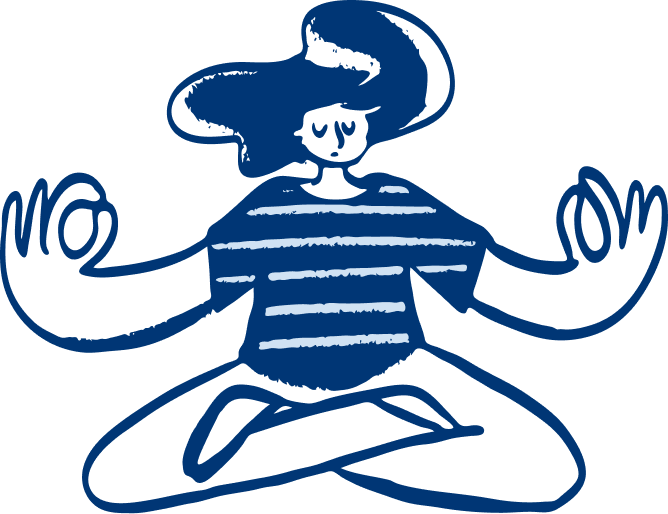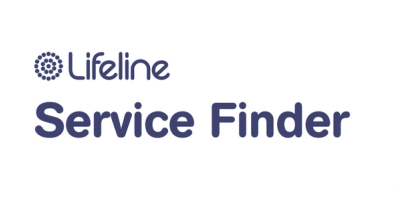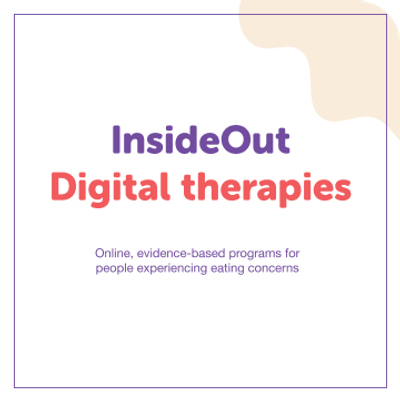Long-term help for managing eating challenges and EDs
Eating challenges (disordered eating) and eating disorders (EDs) can make you feel stuck in a cycle where emotions, triggers, and behaviours seem impossible to escape. It’s completely understandable to feel unsure about what to do next.
While coping strategies like grounding techniques and self-care can offer relief in the moment, there are many things you can do to help you manage in the long term.
Below, you’ll find ideas to help you take those steps at your own pace, focusing on self-compassion and growth along the way.
Tips for healing in the long term
When it comes to healing in the long term, having people you trust in your corner can make a world of difference. Friends, family, or even colleagues can provide encouragement, understanding, and practical help during challenging times.
Here are a few ways to strengthen your support network:
- Identify your safe people: Think about who makes you feel understood and supported, and consider sharing your feelings with them
- Be clear about your needs: Let others know how they can help, like avoiding certain topics or checking in on how you’re feeling
- Turn to professional resources: If personal relationships feel strained, helplines like Butterfly's 1800 ED HOPE or support groups offer a neutral, caring space to share what’s on your mind.
It’s okay to lean on others while focusing on your own growth. Support is a two-way street, and you’re worth it. Click here to learn more about building strong social connections.
Continue reading for more tips.
Form habits that support your healing
Our daily habits shape how we feel, think, and care for ourselves. When it comes to eating challenges, EDs, and body image, even small, positive changes can make a big difference over time. Building habits that support your wellbeing isn’t about getting it ‘right’ every time; it’s about finding routines that feel sustainable and help you feel calm, in control, and confident.
Here are some habits to explore at your own pace:
- Create morning and evening practices
Morning
Set a positive tone for the day by reflecting on a supportive thought or intention. This might sound like:
- ‘I’m learning to listen to my body’s needs.’
- 'I’m proud of the steps I’m taking to build a healthier relationship with food.’
These simple affirmations can help you focus on growth and self-compassion as you move through your day.
Evening
Take a moment at the end of each day to write down one to three things you feel grateful for related to your healing.
This might include:
- Enjoying a meal without guilt
- Feeling more at ease around food
- Appreciating your body for what it can do, not just how it looks.
Over time, this practice can help you notice progress in meaningful ways.
- Set regular meal times
- Try body-positive activities
Swap social media for a new habit
Social media can sometimes amplify feelings of self-doubt or comparison, especially when it comes to body image, eating challenges, and EDs.
Taking a step back from scrolling and replacing that time with a new, supportive habit can help you feel more grounded, reduce stress, and create space for activities that truly nurture your wellbeing.
Ideas for new habits to try:
- Creative activities: Swap scrolling for journaling, drawing, or crafting. These activities give you a way to express your thoughts and feelings in a calming, productive way.
- Mindful movement: Take a short walk, try gentle yoga, or simply stretch. Moving your body with intention can help you feel more present and grounded.
- Engage your senses: Replace screen time with sensory activities like listening to music, lighting a candle, or enjoying a warm drink. These small rituals can be soothing and help you unwind.
- Connect in real life: Spend time with a friend, call a loved one, or join a local class or group. Building real-world connections can help you feel supported and less isolated.
- Learn something new: Use the time to explore a hobby, read a book, or listen to a podcast on a topic you enjoy. Learning can provide a positive distraction and build your sense of accomplishment.
- How to make the swap easier
- Set aside specific times for social media use and stick to them
- Start with a small goal, like replacing 10 minutes of scrolling with another activity, and build from there
- Curate your social media feeds to follow body-positive or supportive accounts that uplift you if completely stepping away feels too hard.
Even small changes in how you spend your time can have a big impact on your mental health and overall wellbeing. By swapping social media for habits that bring joy or relaxation, you’re prioritising yourself in ways that truly matter.
Understanding healthy and unhealthy eating and exercise patterns
Our relationship with food and exercise is personal, and it’s common for it to feel complicated at times. Recognising patterns that support your wellbeing and those that might be making things harder can help you create habits that feel healthier and more sustainable.
This isn’t about judgement or striving for perfection. It’s about building awareness of how certain actions impact your physical and emotional wellbeing, so you can better understand what feels right for you.
Below, you’ll find examples of both healthy and unhealthy eating and exercise behaviours. These aren’t rules but tools to help you reflect on your own experiences and consider areas where you might want to focus your energy and care.
- Healthy eating and exercise patterns
Eating
- Eating a variety of foods from all food groups (e.g., cereals, dairy, meat, fruit, and vegetables)
- Including protein, carbohydrates, and fats in your diet
- Having a fluctuating appetite and responding to hunger or fullness cues
- Enjoying all types of food, including during social situations or cultural events
- Eating mindfully and being flexible about your food choices
- Eating regularly (every 3–4 hours) with adequate portions and snacks to support your body’s needs
- Drinking enough water
- Managing emotions without relying on dieting or exercise
- Feeling relaxed and at ease about food choices
- Enjoying 1–2 standard alcoholic drinks, if desired.
Exercise
- Resting and moving your body in different ways at varying intensities
- Exercising within recommended activity guidelines and for enjoyment or performance
- Exercising in ways that support mental, emotional, and physical wellbeing
- Taking rest days and breaks from exercise routines when on holiday, injured, or unwell
- Pairing exercise with proper nutrition to promote recovery.
Click here to download InsideOut’s Fact Sheet on Healthy vs Unhealthy Behaviours.
- Unhealthy eating and exercise patterns
Letting go of tracking
Keeping track of calories, weight, or exercise stats can feel like a way to stay in control, but over time, it can often lead to feelings of anxiety, self-criticism, or fixation.
Letting go of tracking might feel challenging at first, but it can help you focus on how you feel, not what the numbers say.
Here are some tips to help you take that step:
- Take a break from the scale: If weighing yourself causes stress, consider stepping away from it for a while or even removing it from your space altogether. This can help shift your focus to what your body needs and how it feels, rather than a number that doesn’t define your worth.
- Celebrate non-numerical progress: Instead of tracking calories or reps, notice other signs of progress, like feeling more energised, enjoying a walk outside, or having a meal without guilt. These moments are meaningful milestones that reflect real growth and healing.
- Trust a professional when tracking is necessary: If monitoring weight or intake is part of your health plan, let a trusted health professional handle it. They can offer insight without the emotional pressure of self-tracking.
If this feels especially difficult, reaching out to a counsellor or a support group can give you guidance and encouragement. You’re not alone, and it’s okay to ask for help as you explore healthier ways of caring for yourself.
Listen to stories of others
Healing can feel overwhelming and isolating. But hearing from others who have struggled, found support, and slowly rebuilt their lives can be a powerful reminder that recovery is possible.
Below, you can listen to the InsideOut Institute Podcast episodes featuring Jenny, Sabeena, and Sarah - three people with different journeys but a common thread of resilience. Jenny lived with an eating disorder for 50 years before finding the right support. Sabeena’s story weaves through trauma, addiction, and self-discovery. Sarah, once trapped in compulsive exercise, is now an exercise physiologist who helps others heal their relationship with movement.
Alongside these lived experiences, leading experts provide insight into the complex nature of eating disorders and recovery. Dietitian Fiona Sutherland explores how mindful eating can help break free from diet culture and support lasting healing. Clinical psychologist Dr Sophie Reid unpacks the deep connection between trauma and disordered eating. And Sarah shares practical ways to rebuild a balanced relationship with movement.
Understanding your treatment options
There are many treatment options available to support eating challenges, EDs, and body image struggles. Finding the right one depends on your needs and comfort level.
There’s no one-size-fits-all approach to therapy. Different techniques work for different people, and that’s completely okay. Finding the right fit might take time, but it’s worth exploring.
Here are three types of therapies that may help with your recovery:
- Dialectical behaviour therapy (DBT): Teaches practical skills for managing intense emotions, navigating distress, and practising mindfulness. DBT is particularly helpful for eating disorders, as it supports you in developing emotional regulation, distress tolerance, and self-compassion, all tools that can make triggers feel more manageable and reduce urges to engage in patterns you’re trying to change. You can use the Lifeline Service Finder to find a DBT therapist near you.
- Acceptance and commitment therapy (ACT): Helps you acknowledge difficult emotions while taking meaningful actions guided by your personal values. Click here to learn more.
- Cognitive behavioural therapy (CBT): Focuses on identifying and challenging negative thought patterns that may contribute to disordered behaviours. Click here to learn more.
Therapy can be adapted to meet your unique needs, and it’s okay to explore different options until you find one that feels right for you.
Click here to read our article about finding the therapist that’s right for you.
You can also consider speaking with a dietician or GP.
A dietician can provide guidance on balanced eating in a supportive, non-judgemental way, while a GP can offer guidance and a Mental Health Treatment Plan.
What is a Mental Health Treatment Plan?
If you’re feeling stuck or unsure how to move forward, speaking to your GP can be a great starting point. They can help you explore options for ongoing support, including creating a Mental Health Treatment Plan.
A Mental Health Treatment Plan is a personalised plan that your GP develops with you. It can provide access to Medicare-subsidised sessions with mental health professionals, such as psychologists, dietitians, or counsellors, who specialise in areas like eating challenges, body image, and emotional wellbeing.
If you feel nervous about the conversation, you don’t need to have everything figured out beforehand. Just sharing how you’ve been feeling is a meaningful first step. Your GP is there to listen and help guide you toward the support that feels right for you.
Click here for more details about Mental Health Treatment Plans and how they work.
What else can you try?
Explore online self-led therapy for EDs
Online therapies can be a great starting point, especially if you’re unsure about seeking in-person help or looking for additional support alongside other treatments.
These therapies often provide evidence-based strategies, like cognitive behavioural therapy (CBT), to help you understand and change unhelpful thoughts, feelings, and patterns.
Benefits of online therapies:
- Convenience: Access support from the comfort of your home, fitting sessions into your schedule
- Anonymity: If you feel nervous about in-person therapy, online options can feel less intimidating
- Tailored support: Many programs are designed specifically for eating disorders, offering strategies to address your unique needs.
One resource to explore is InsideOut Digital Therapies, which offers free online therapy programs tailored to individuals experiencing eating concerns or eating disorders. These programs are designed to guide you through structured, self-paced sessions that focus on developing healthier ways of thinking and coping.
Consider joining an ED support group
Support groups can be a valuable resource for navigating eating concerns or EDs. These groups provide a safe, understanding space where you can connect with others who share similar experiences.
Whether online or in-person, support groups can offer benefits like:
- Connection: Being around people who understand what you’re going through can help reduce feelings of isolation and remind you that you’re not alone
- Shared experiences: Hearing from others can provide new insights, practical tips, and encouragement as you navigate challenges
- Non-judgemental support: Support groups offer a compassionate environment where you can share your thoughts and feelings openly, without fear of judgement
- Tailored support: Many groups are designed to focus on specific eating disorders or challenges, such as binge eating disorder, bulimia nervosa, or body image struggles, making the guidance feel more relevant to your experience.
- Where to find support groups for eating challenges and EDs
- Butterfly Foundation: Offers online support groups tailored to eating concerns and body image, led by trained facilitators in a safe and respectful space. Click here to learn more.
- Eating Disorders Victoria (EDV): Provides in-person and national virtual group options where you can connect with others for mutual support and encouragement. Click here to learn more.
- InsideOut Institute: Offers resources and can guide you toward support groups in your area or online that suit your needs. Click here to learn more.
Try using an ED recovery app
ED recovery apps like Recovery Record are designed to provide structure and encouragement, helping you build healthier habits, track your progress, and feel more supported as you navigate your healing journey.
Recovery Record can help you:
- Gain awareness around your patterns, triggers, and achievements, giving you a clearer view of your experiences and growth over time.
- Encourage accountability through goal-setting and daily check-ins.
- Offer guidance and resources, including motivational messages, mindfulness exercises, and coping tools to help you manage triggers and build resilience.
Recovery apps are not a replacement for professional care, but they can complement your efforts and help you stay connected to your goals. Click here to explore more tools and apps that may help with your healing.
“Recovery Record, alongside my family and treatment team, is the main thing that kept me on track, motivated, honest, and excited about recovery.”
Tips for staying motivated
Healing can feel slow at times, but every step forward, no matter how small, is meaningful. Staying motivated often means focusing on what truly matters to you and recognising the progress you’re making along the way.
- Ways to stay motivated and celebrate progress
- Reconnect with your ‘why’: Reflect on why healing matters to you. It could be feeling more at ease with yourself, reconnecting with loved ones, or simply finding more moments of peace.
- Share your progress: Talk about your achievements with someone who supports you, like a friend, family member, or counsellor.
- Celebrate small wins: Whether it’s eating without guilt, attending a social meal, or practising a coping strategy, every step forward deserves recognition. Recognising these moments can help you stay motivated and build confidence.
- Treat yourself with kindness: Reward your efforts with something uplifting, like a favourite song, a relaxing activity, or simply taking a moment to pause and appreciate how far you’ve come.
- Embrace flexibility: Remember, healing isn’t a straight line. Setbacks are part of the process, and every effort you make is progress, even if it doesn’t feel perfect.
Taking steps toward long-term healing can feel challenging at times, but it’s important to remember that support is always available. Whether it’s exploring tools and apps designed to help with eating challenges and body image or reaching out to services like Butterfly or InsideOut, there are resources to guide you every step of the way.
If you’re looking for practical ways to support your journey, visit our tools and apps page for a range of helpful resources. For personalised guidance and connection to professional support, explore our support services page.
No matter where you are right now, help is here, and there’s hope for a healthier, more balanced future.
Click here to download, save, or print our eating and body image fact sheet.







